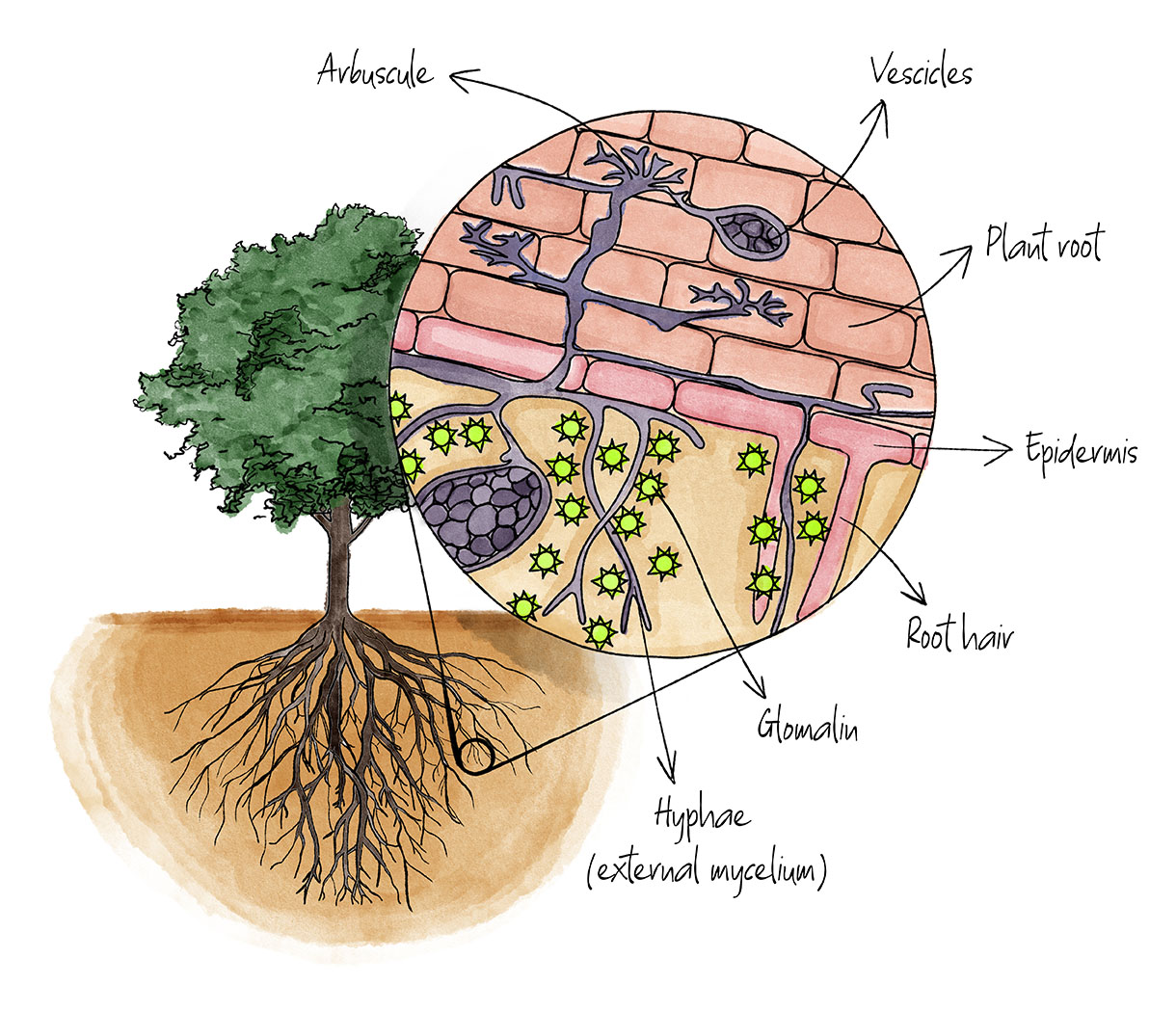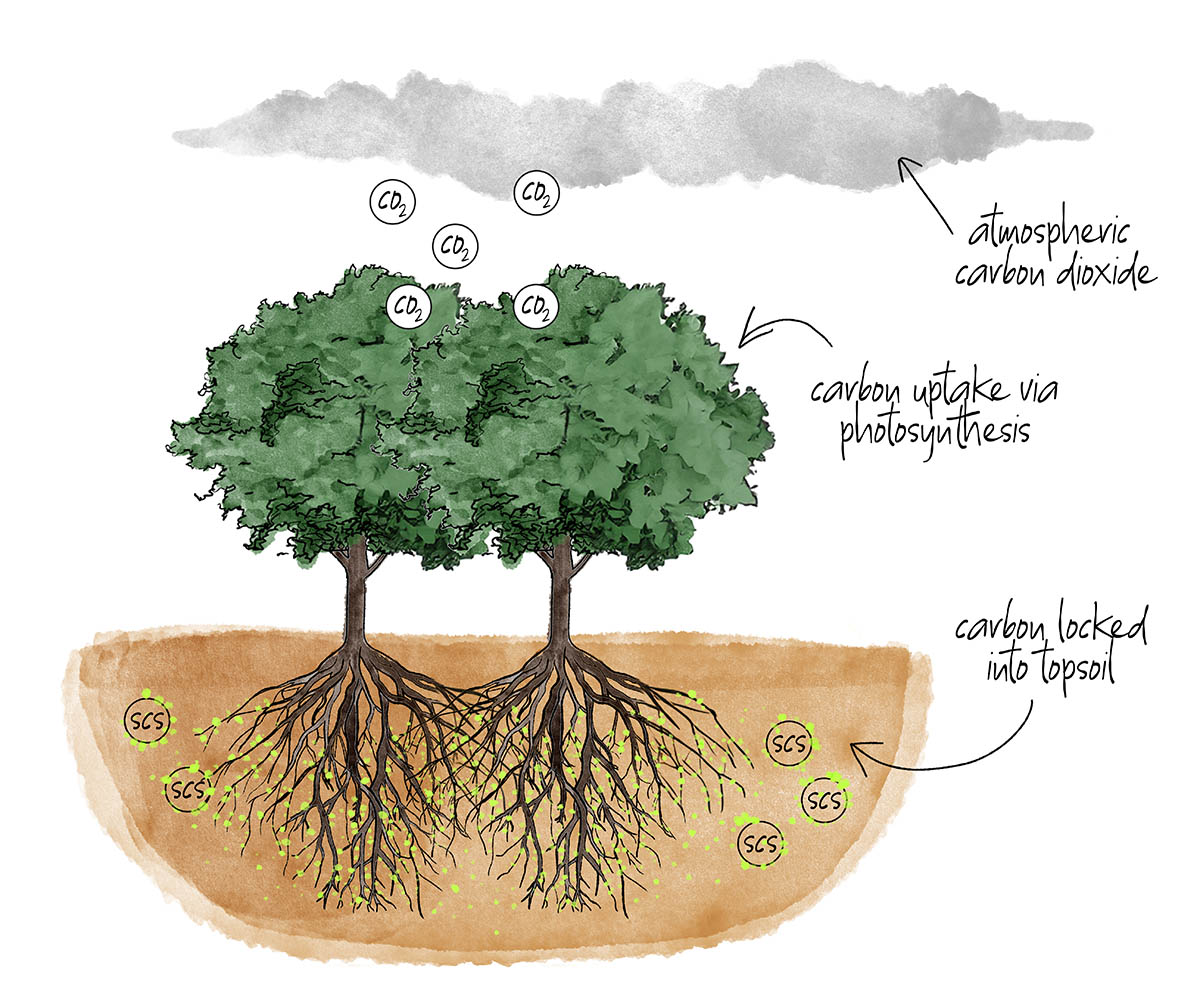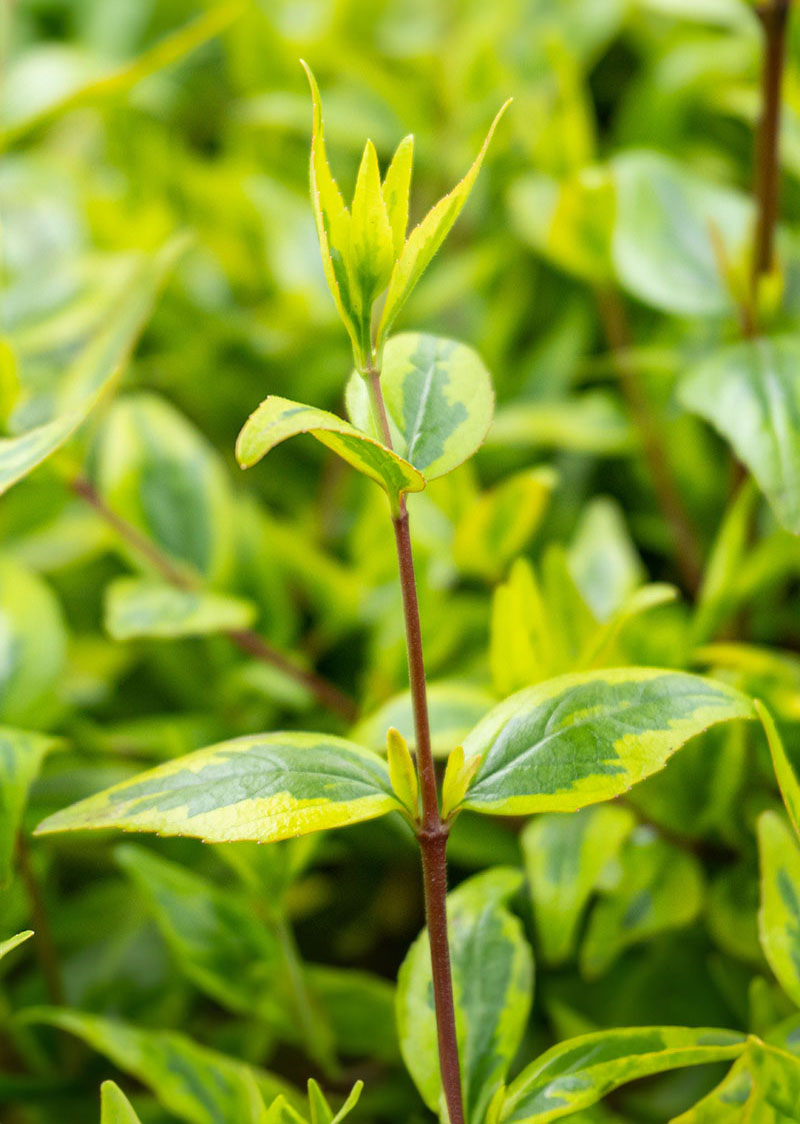Glomalin as soil’s secret to sustainability
The role of glomalin in enhancing soil health and stability
Sustainable soil management is a key issue in global horticulture and agriculture, and the search for innovative and natural solutions is more urgent than ever. Among the most promising discoveries of recent decades, glomalin is a crucial element to improve soil health and address environmental challenges.
Glomalin is a glycoprotein (protein with a carbohydrate chain attached) produced by arbuscular mycorrhizal fungi (AMF) (to know more about soil fungi, read our blog ‘The importance of soil fungi’), which plays a crucial role in soil health and structure. A relatively recent discovery, glomalin has been identified as an essential component in the formation of soil aggregates, contributing to soil stability and water-holding capacity.
Its importance lies in its ability to improve soil quality through several mechanisms. First, glomalin acts as a natural glue, binding soil particles and forming stable aggregates. This process, in addition to preventing erosion, also improves soil porosity, facilitating water infiltration and aeration. Glomalin is rich in carbon, which makes it an important storage of organic carbon in the soil, contributing to climate change mitigation.

Ai-generated glomalin under the microscope
Discovery and initial research
In 1996, American researcher Sara F. Wright, working at the United States Department of Agriculture (USDA), made the discovery of glomalin. Wright and her team were studying the role of mycorrhizal fungi in forming soil aggregates when they identified a unique glycoprotein. Glomalin is named after arbuscular mycorrhizal fungi of the genus Glomus, which are the main producers of this glycoprotein. Glomalin protects the fungi’s hyphae from nutrient loss and desiccation, allowing them to survive in harsh environmental conditions. Arbuscular mycorrhizal fungi (AMF) form a mutual symbiosis with plants, exchanging essential nutrients such as phosphorus and zinc for carbon derived from photosynthesis. The discovery of glomalin has opened up new avenues in soil research, leading to a critical understanding of how mycorrhizal fungi contribute to soil health and sustainability.
Early research has shown that glomalin is rich in carbon and can provide a significant reserve of organic carbon in soil. This has important implications for combatting climate change, as soil carbon sequestration is a key strategy to reduce atmospheric carbon dioxide concentration. In addition, subsequent studies have highlighted the role of glomalin in improving plant resistance to environmental stress, from drought and soil salinity.
Over the past 25 years, various studies have attributed numerous benefits to glomalin, including soil aggregation, carbon storage, soil nutrient content and distribution, soil biodiversity, removal of heavy metals and other pollutants via chelation, and plant productivity. Despite some controversy over the exact nature of glomalin, its association with a long list of plant and soil health benefits has been consistently confirmed.

Arbuscular mycorrhizal fungi form arbuscules and vesicles within the cortical cells of the root. The exchanges that occur between the fungus and the plant cell take place at the level of the arbuscules. AMF produce glomalin, which protects the hyphae from nutrient loss and desiccation.
The properties of glomalin
Glomalin has a complex structure that gives it unique properties: recalcitrance for slower decomposition, ability to sequester carbon, hydrophobicity to aid water retention, and chelation, binding itself to heavy metallic pollutant particles in the soil. These characteristics make glomalin a crucial component for soil health and climate change mitigation.
Glomalin recalcitrance
Glomalin is composed of a combination of chemical elements that include carbon (C), hydrogen (H), oxygen (O), nitrogen (N), and phosphorus (P). Glomalin is a glycoprotein, which means it is made of a protein part and a sugar part. The sugar chains and protein residues are linked by glycosidic bonds that give glomalin a complex and stable structure.
This complex structure makes glomalin a recalcitrant molecule, meaning it is resistant to microbial and chemical breakdown. Glomalin’s recalcitrance means it can persist in soil for long periods, continuing to provide environmental benefits. This is particularly important for soil stability, as glomalin helps form stable aggregates that improve soil structure and prevent erosion.
Mechanisms of recalcitrance
- Resistance to microbial decomposition: The complex structure of glomalin makes it difficult for microorganisms to decompose it. This is due to the presence of stable chemical bonds and the hydrophobic nature of the glycoprotein, which limits the access of microorganisms and degradative enzymes.
- Interaction with soil minerals: Glomalin can bind to soil minerals such as iron and aluminum, forming stable complexes that further protect organic carbon from decomposition. These organic-mineral complexes increase the recalcitrance of glomalin and contribute to the stabilisation of soil carbon.
- Physical protection: Soil aggregates formed by glomalin provide physical protection to organic carbon, reducing exposure to decomposers. This physical protection is essential to maintaining carbon sequestered in the soil for long periods.
Its ability to resist decomposition means that the carbon sequestered in glomalin can remain in the soil for decades, contributing to climate change mitigation. Studies have estimated that the average life of glomalin in soil may be about 50 years, making it a key component in long-term carbon sequestration (United States Department of Agriculture (USDA)).
Carbon sequestration
Plants absorb CO2 from the atmosphere through their stomata. Using solar energy, plants combine CO2 with water to produce glucose and oxygen. This chemical reaction is known as photosynthesis. When plants die or lose leaves, roots, and other organic materials, they are broken down by microorganisms in the soil. During this process, the carbon in plant residue is converted into various forms of organic carbon. Glomalin binds to soil particles and forms stable aggregates in the soil. These aggregates protect the organic carbon from microbial decomposition, allowing the carbon to remain sequestered in the soil for long periods of time, helping to reduce the amount of CO2 in the atmosphere.
Its chemical composition, rich in carbon, makes it a significant organic carbon reserve. Studies have shown that glomalin can contain between 36% and 59% carbon. (Aliasgharzad, Nasser & Malekzadeh, Elham. (2024). Glomalin and Carbon Sequestration in Terrestrial Ecosystems. 10.1007/978-981-99-8220-2_11.) This high carbon content contributes directly to the increase of soil organic carbon, a key factor in climate change mitigation.

Did you know?
Glomalin is a tough protein, and extracting it from soil is a hard process that requires a specific technique. Researchers use a method that involves autoclaving the soil sample in a sodium citrate solution at 121°C for an hour. This process is necessary to break the strong interactions between glomalin and other soil components, such as clay particles and organic matter.
Glomalin sequesters carbon at a microbiological level by stabilising it in the soil through chemical bonds. This process is quite different from the peatlands’ one, which are renowned for their exceptional carbon sequestration capacity through the physical accumulation of organic matter. Both mechanisms are crucial for climate change mitigation and represent promising areas of research for future carbon management strategies.
Increasing glomalin production through sustainable practices can significantly contribute to reducing greenhouse gas emissions and promoting environmental sustainability.
Hydrophobicity of glomalin and improvement of soil fertility
Another distinctive property of glomalin is its hydrophobicity, or its tendency not to dissolve easily in water. This property is due to the presence of hydrophobic chemical groups in its structure, which repel water. The hydrophobicity of glomalin also contributes to its persistence in the soil.
The presence of glomalin and its hydrophobicity are closely related to soil health and ecosystem productivity. Glomalin helps improve the soil’s water-holding capacity, reducing erosion and improving nutrient availability for plants. Soil fertility is a crucial element for productivity and environmental sustainability. Among the various factors that influence soil health, glomalin is noted for its significant role in improving soil structure and promoting plant growth.
Glomalin contributes to the formation of stable aggregates in the soil, so improving its physical structure. Soil aggregates are essential to maintain good porosity, which facilitates infiltration and water retention, as well as aeration. The presence of stable aggregates also reduces soil erosion, preserving its integrity and fertility in the long term.
Glomalin also plays a key role in nutrient cycling. It binds essential nutrients, such as phosphorus and nitrogen, making them more available to plants. This process is particularly important in nutrient-poor soils, where nutrient availability can limit plant growth. Additionally, glomalin can positively influence soil microbiology, promoting the growth of beneficial microorganisms that further contribute to nutrient availability.
Glomalin’s ability to improve soil structure has a direct impact on water retention. Soils with good aggregate structure retain water better, reducing the need for irrigation and increasing plant resilience under water stress. This is particularly relevant in areas prone to drought, where efficient water management is crucial for agricultural productivity.
Plants that grow in soils rich in glomalin tend to develop more robust root systems, improving nutrient and water uptake. This leads to more vigorous growth.

Good soil structure has adequate space (pores) between aggregates to alleviate compaction so that air and water can reach plant roots. Glomalin acts as a glue that binds soil particles together, stabilising aggregates and enhancing soil structure.
Application of glomalin in the remediation of contaminated soils
Glomalin plays a vital role in the remediation of lightly contaminated soils due to its unique properties of stabilising heavy metals. The property of glomalin to bind to heavy metals is called chelation.
Glomalin interacts with heavy metals through adsorption and complexation processes. Adsorption occurs when heavy metals physically bind to the surface of glomalin, while complexation involves the formation of chemical bonds between metals and functional groups in the glomalin structure. These processes reduce the solubility of metals, making them less available for plant uptake and decreasing the risk of groundwater contamination.
Glomalin bonds strongly with heavy metals such as cadmium (Cd), lead (Pb) and zinc (Zn). When these metals bind to glomalin, they form stable complexes that prevent their mobility in the soil. This is particularly important in slightly contaminated soils, where the mobility of heavy metals can lead to contamination of plants and water resources.
The long-term stability of glomalin means that its benefits in remediating contaminated soils last over time. The continued presence of glomalin in soil ensures that heavy metals remain immobilised, reducing the risk of future release of contaminants.

Tips on how to increase glomalin in soil
Increasing glomalin in soil is essential for improving soil structure and plant health. Below are some practical tips for increasing levels of this important glycoprotein through sustainable soil management techniques.
1. Arbuscular Mycorrhizal Fungi (AMF) inoculation
AMF forms a symbiosis with plant roots, penetrating root cells and forming structures called arbuscules. These arbuscules increase the root’s surface area for absorption, improving the uptake of nutrients such as phosphorus, nitrogen and micronutrients. AMF inoculation can be particularly useful in nutrient-poor soils or in soils that have undergone intensive treatments that have reduced the population of beneficial fungi. The use of commercial inoculants can help re-establish a healthy AMF population, improving the health of plants.
2. Plant rotation
Plant rotation is the practice of planting different varieties sequentially on the same plot of land. It promotes soil microbial diversity, as different plants host different microbial communities. This helps prevent the accumulation of plant-specific pathogens and maintain a healthy balance of beneficial microorganisms. Alternating annuals with perennials for example can help maintain soil health and promote the growth of arbuscular mycorrhizal fungi (AMF).
3. Reduce tillage
Intensive tillage can destroy soil aggregates and reduce AMF populations. Reduced tillage techniques help preserve soil structure and maintain a favourable environment for mycorrhizal fungi. For example, avoiding deep digging around plant roots can help preserve AMF.
4. Use of compost and manure
Compost and manure improve the organic matter in the soil, providing essential nutrients for the growth of AMF. These organic materials also improve soil structure and increase water holding capacity. They can be applied as mulch or incorporated superficially into the soil.
5. Avoid use of chemical fertilisers
Excessive use of chemical fertilisers can alter the soil microbial balance and reduce the AMF population. Chemical fertilisers can also cause salt accumulation in the soil, which can be harmful to plants. Adopting sustainable fertilisation practices, such as the use of organic, natural fertilisers and integrated nutrient management, can help maintain a better environment for the growth of mycorrhizal fungi and the production of glomalin.
6. Integrate plants that promote AMF growth and glomalin production
Integrating plants that promote the growth of arbuscular mycorrhizal fungi (AMF) can be an effective strategy to increase glomalin levels in the soil.
Plants that promote AMF growth and glomalin production
Plants that promote arbuscular mycorrhizal fungi (AMF) growth and glomalin production share some key properties. They form symbiotic relationships with AMF, enhancing the uptake of essential nutrients such as phosphorus and nitrogen. They are adaptable to different soil conditions, even thriving in less fertile environments. They contribute to the formation of stable aggregates in the soil, improving porosity, infiltration and water retention. They also increase organic matter through leaf fall and litter decomposition, providing nutrients to soil microorganisms and improving soil structure. Many of these plants are also resistant to various soil diseases, maintaining a healthy population of AMF, which is crucial for glomalin production.
Abelia × grandiflora
This shrub is known for its ability to form symbiosis with AMF, improving the absorption of phosphorus and nitrogen, essential for the production of glomalin.
Acer campestre
A UK native, decidious tree that significantly promotes AMF growth and glomalin production. Adaptable to different soil conditions, it increases organic matter and improves soil structure. It is also resistant to several soil diseases.
Aucuba japonica
An evergreen shrub with roots that provide a good environment for AMF, improving the absorption of essential nutrients. This plant thrives in a variety of soil types and lighting conditions, and is resistant to several soil-borne diseases.

Abelia × grandiflora

Aucuba japonica ‘Crotonifolia’
Acer campestre
A UK native, decidious tree that significantly promotes AMF growth and glomalin production. Adaptable to different soil conditions, it increases organic matter and improves soil structure. It is also resistant to several soil diseases.
Aucuba japonica
An evergreen shrub with roots that provide a good environment for AMF, improving the absorption of essential nutrients. This plant thrives in a variety of soil types and lighting conditions, and is resistant to several soil-borne diseases.
Cornus alba
Known for its colourful branches, it supports the growth of AMF, improving soil structure and increasing glomalin production.
Cotoneaster dammeri
This ground cover shrub is used to cover the ground and prevent erosion. Its roots form symbiotic relationships with AMF, improving soil structure.
Hebe
Species such as ‘Blue Gem’ and ‘Midsummer Beauty’ are known for their colourful flowers and hardiness. Hebe roots form symbiotic relationships with AMF, improving soil structure.
Lavandula angustifolia
Lavender is very popular for its scent and beauty. It supports the growth of AMF, improving nutrient uptake and contributing to the production of glomalin.
Rose
Varieties such as Rosa (H) ‘Kent’ and Rosa ‘Grouse’ are prized for their beauty and scent. Rose roots form symbiotic relationships with AMF, improving soil structure.
Vinca minor
This ground cover plant is used to cover soil and prevent erosion. It promotes the growth of AMF, improving nutrient uptake.

Hebe ‘Wiri Charm’

Lavandula angustifolia ‘Dwarf Blue’

Rosa ‘Kent’

Vinca minor
Future applications
The potential future applications of glomalin are vast and promising, with significant implications for sustainable agriculture, climate change mitigation, bioremediation and biodiversity conservation.
In agriculture, glomalin could soon be used to develop bio-fertilisers that improve soil health without the use of chemical fertilisers. These bio-fertilisers could increase soil fertility, improve water retention, and reduce erosion, contributing to more sustainable and environmentally friendly agricultural practices.
Glomalin could be key in future climate change mitigation. Its ability to stabilise soil organic carbon could be utilised through innovative agricultural practices, such as the integration of cover crops and crop rotations that favour the production of glomalin. These practices could increase the soil’s capacity to store carbon, helping to reduce CO2 concentrations in the atmosphere.
Glomalin could also be used for the decontamination of contaminated soils, through bioremediation. Its ability to improve soil structure and promote microbial growth could accelerate the degradation of contaminants and improve soil quality. This approach could be particularly useful in industrial or mining areas where soil contamination is a significant challenge.
Lastly, glomalin could play a key role in the conservation of soil biodiversity. Through promoting soil health, glomalin could support a wider rangeof plants and microorganisms, contributing to ecosystem resilience. The conservation of soil biodiversity is essential to maintain ecosystem services, such as organic matter decomposition, nutrient cycling, and climate regulation.
Glomalin is a promising area of research with potential applications in a variety of sectors. Further research and innovation could unlock new opportunities to harness the benefits of this soil protein, contributing to a more sustainable and resilient future.

